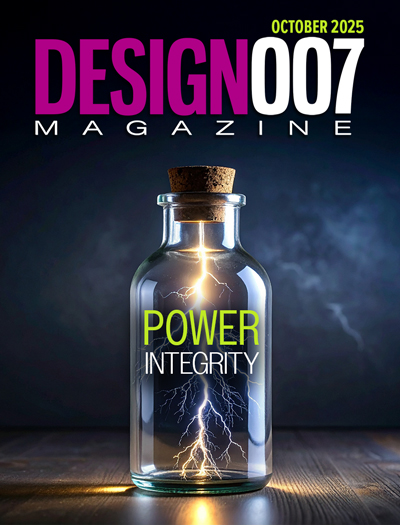-

- News
- Books
Featured Books
- design007 Magazine
Latest Issues
Current Issue
Power Integrity
Current power demands are increasing, especially with AI, 5G, and EV chips. This month, our experts share “watt’s up” with power integrity, from planning and layout through measurement and manufacturing.

Signal Integrity
If you don’t have signal integrity problems now, you will eventually. This month, our expert contributors share a variety of SI techniques that can help designers avoid ground bounce, crosstalk, parasitic issues, and much more.

Proper Floor Planning
Floor planning decisions can make or break performance, manufacturability, and timelines. This month’s contributors weigh in with their best practices for proper floor planning and specific strategies to get it right.
- Articles
- Columns
- Links
- Media kit
||| MENU - design007 Magazine
Dye-based Device Sees the Invisible
April 16, 2021 | ACN NewswireEstimated reading time: 1 minute
Scientists in Europe have designed an organic dye-based device that can see light waves in the shortwave infrared (SWIR) range. The device is easy to make using cheap materials, and is stable at high temperatures. The findings, published in the journal Science and Technology of Advanced Materials, could lead to more widespread use of inexpensive consumer SWIR imaging and sensing devices.
The human eye can only detect a very narrow segment of the electromagnetic spectrum, from around 400 to 700 nanometers. The SWIR region, on the other hand, extends from 1,000 to 2,500 nanometers. Specially designed cameras can take images of objects that reflect waves in the SWIR region. They are used for improving night vision, in airborne remote sensing, and deep tissue imaging. The cameras also help assess the composition and quality of silicon wafers, building structures and even food produce.
"These cameras are typically difficult to manufacture and are quite expensive, as they are made of inorganic semiconductor photodiode arrays interconnected with read-out integrated circuitry," says Roland Hany of the Swiss Federal Laboratories for Materials Science and Technology.
Hany worked with colleagues in Switzerland and Italy to design an organic dye-based 'SWIR upconversion device' that efficiently converts shortwave infrared light to visible light.
The device uses organic (materials made with carbon) components: a squaraine dye-coated flexible substrate combined with a fluorescent organic light-emitting diode (OLED). When the dye absorbs SWIR waves, an electric current is generated and directly converted into a visible image by the OLED.
The team had to play with the molecular composition of several squaraine dyes to get them to absorb specific wavelengths. Ultimately, they synthesized squaraine dyes that absorb SWIR light beyond 1,200 nanometers and remained stable up to 200 degrees Celsius. The finished dye-based device performed stably for several weeks under normal laboratory conditions.
"All-organic upconverters could lead to applications that can't be realized with current technology. For example, invisible night vision devices can be directly integrated into car windscreens without affecting the visual field," explains Hany.
The team is now working on shifting the dye's absorption further into the SWIR range. They are also using machine learning techniques to find new dye molecules capable of sensing SWIR waves. Finally, the team aims to improve device stability and sensitivity.
Testimonial
"The I-Connect007 team is outstanding—kind, responsive, and a true marketing partner. Their design team created fresh, eye-catching ads, and their editorial support polished our content to let our brand shine. Thank you all! "
Sweeney Ng - CEE PCBSuggested Items
Sealed for Survival: Potting Electronics for the Toughest Environments
10/29/2025 | Beth Massey, MacDermid Alpha Electronics SolutionsElectronics deployed in harsh conditions face relentless threats from vibration, impact, chemical contaminants, airborne pollutants, and moisture, conditions that can quickly lead to failure without robust protection. Potting, the process of encapsulating electronics in a protective polymer, is a widely used strategy to safeguard devices from both environmental and mechanical hazards.
Driving Innovation: Mechanical and Optical Processes During Rigid-flex Production
10/28/2025 | Kurt Palmer -- Column: Driving InnovationRigid-flex printed circuit boards are a highly effective solution for placing complex circuitry in tight, three-dimensional spaces. They are now indispensable across a range of industries, from medical devices and aerospace to advanced consumer electronics, helping designers make the most efficient use of available space. However, their unique construction—combining rigid and flexible materials—presents a fundamental challenge for PCB manufacturers.
SMTAI 2025 Review: Reflecting on a Pragmatic and Forward-looking Industry
10/27/2025 | Marcy LaRont, I-Connect007Leaving the show floor on the final afternoon of SMTA International last week in Rosemont, Illinois, it was clear that the show remains a grounded, technically driven event that delivers a solid program, good networking, and an easy space to commune with industry colleagues and meet with customers.
ITW EAE Despatch Ovens Now Support ASTM 5423 Testing
10/15/2025 | ITW EAEAs the demand for high-performance electrical insulation materials continues to grow—driven by the rapid expansion of electric vehicles (EVs) and energy storage systems—thermal processing has become a critical step in material development.
Beyond Thermal Conductivity: Exploring Polymer-based TIM Strategies for High-power-density Electronics
10/13/2025 | Padmanabha Shakthivelu and Nico Bruijnis, MacDermid Alpha Electronics SolutionsAs power density and thermal loads continue to increase, effective thermal management becomes increasingly important. Rapid and efficient heat transfer from power semiconductor chip packages is essential for achieving optimal performance and ensuring long-term reliability of temperature-sensitive components. This is particularly crucial in power systems that support advanced applications such as green energy generation, electric vehicles, aerospace, and defense, along with high-speed computing for data centers and artificial intelligence (AI).


